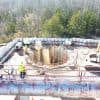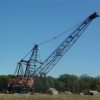PROJECT DETAILS
The White River Hydroelectric Power project is located near Batesville, Arkansas. Batesville is the second oldest municipality in the state of Arkansas, after Georgetown. It was named for James Woodson Bates who settled in the town and was the first territorial delegate from Arkansas to the Congress of the United States. Batesville has also gone by the names of Napoleon and Polk Bayou.
In early days, Batesville was an important port on the White River and served as an entry point to the interior of northern Arkansas. Batesville played a large role in the settling of the Ozark Mountains region and served as the central land office for northern Arkansas
The first known settlement of the Batesville area was in 1810 near the mouth of Polk Bayou, and by 1819 the town had a ferry across the White River and about a dozen houses. The town was partially laid out in early 1821, and on March 3, 1822 a bill of assurance was recorded and executed and the town’s plat was laid out. Batesville became the county seat in 1821. In January 1822, Judge Richard Searcy opened the town’s first state circuit court. The town’s first post office was established in 1822, and in 1830 became the home of a county court. On 25 September 1836, shortly after Arkansas was granted its statehood, Governor Conway incorporated Batesville Academy, the state’s first academy. In the past, the area in and around the city had extensive quarries of manganese ore, phosphate rock, sandstone, limestone, and marble. Currently Arkansas Lime owns and operates a lime kiln nearby and there are a few limestone quarries operating in the area.
A major event occurring around the turn of the century was the beginning of construction of three locks and dams to make White River navigable above Batesville. According to the U. S. Army Corps of Engineers, the River and Harbors Act of March 1899, authorized ten fixed dams with concrete locks between Batesville and Buffalo Shoals. Three of these locks and dams were completed; No. 1 at Batesville and Nos. 2 and 3 up the river from the town. Lock and dam No. 1 was placed into operation October 16, 1903, and the other two were not far behind, but while construction was going on, the railroad began building the White River Division which paralleled the river to Cotter. The railroad with through connections offered better service and the lock and dam project was dropped after No. 3 was finished. However, the government maintained the three which were built until 1951.
After the locks and dams were taken out of service they were sold by the U. S. Army Corps of Engineers for private ownership. This is the only time in the history of the United States that this had ever been done. Eventually Independence County acquired ownership of all three of them and plans were made to convert the old locks into hydro-electric generating stations.







